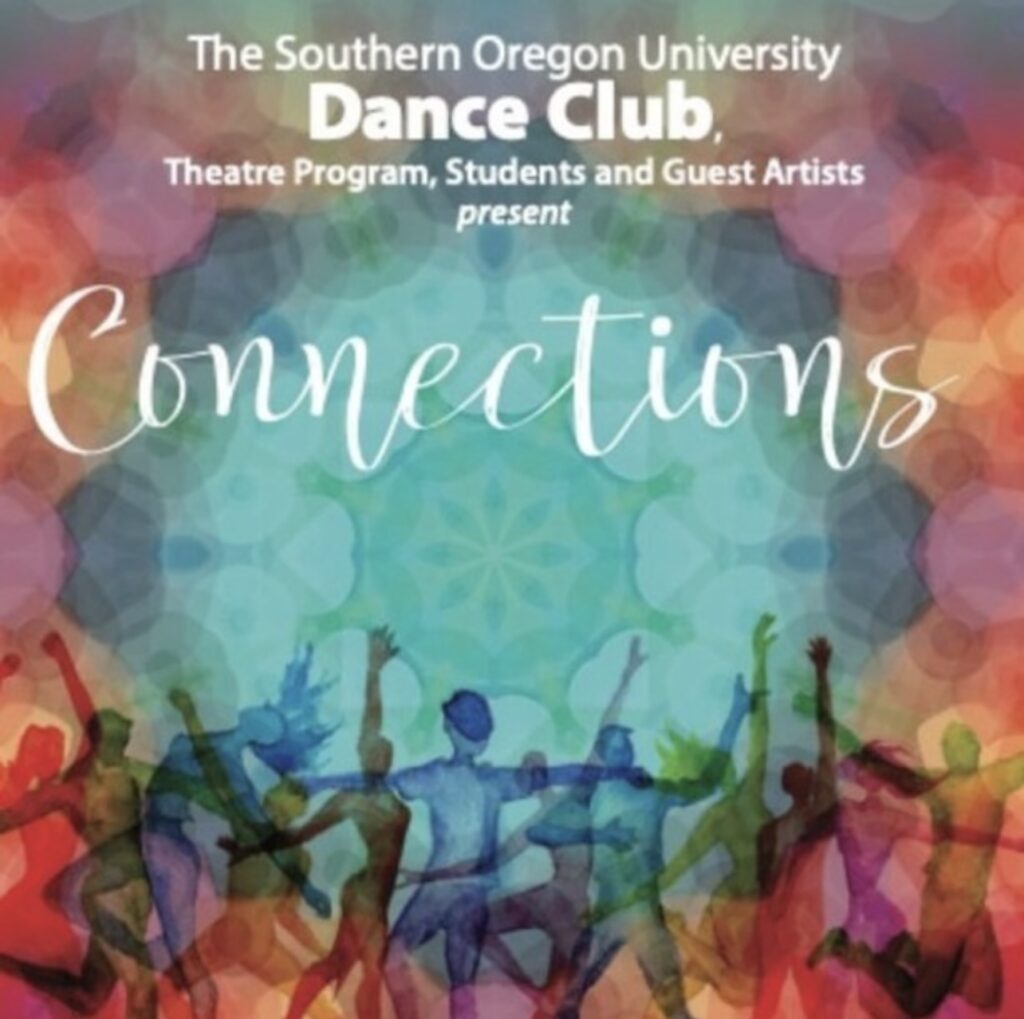Dancing, live music, storytelling–they do it all! SOU’s very own Dance Club took to the Main Stage Theater and connected dances, stories, and music from all over–suppose the name fits the theme–featuring student-choreographed performances, guest-choreographed performances, and a “Farewell, SOU” performance from the OCA’s beloved Suzanne Seiber.
Starting off the evening (and afternoon, for the Sunday matinee), the dance performances were preceded by live music as the audience flooded into the seats. The musicians were Tom Freeman on drums, Steve Elmer on tuba, and Paul Jenny on guitar and vocals. Their music set the scene for the performances to come, giving the audience something to sway with as they flocked to their seats. After an introductory speech from Seiber and the Dance Club members–Natalie Guidi, Kaya Scott, Lucy Kaelin, and Lea Beaubien–it was time for dancing.
Starting the show off was Felicia Florendo, an award-winning dancer, and performer, honored Head Woman Dancer at the LCC powwow, and traveling member of the Dancing Spirit Drum Group in Ashland. Her piece “Native American Fancy Dance,” dazzled the audience with her vibrant moves and colorful outfit swaying with every step and hop. The music and lighting accompanying her dance set the tones of day and night, featuring Northern Cree’s “No Stops” and “Wicked” and morning hues shifting to indigos and midnight blues halfway through the performance.
Following Florendo was Lili Fuller, dance choreographer and director for film, theatre, tv, music videos, and more–having worked with the likes of the Gay Men’s Chorus of LA, ETC Theatre Company, and USC School of Dramatic Arts, as well as co-founding and serving as the Artistic Director for the Boom Kat Dance Theatre. Fuller worked alongside Lea Beaubien, Emily Wilson, Juliet Wilson, Lucia Kaelin, Katie Haegele, Sarah Ginther, Aven Ginther, Stella Nichols, and Shoko Mann to choreograph the piece “Heaven I Know.” Their piece showcased a story of people and their devotion to devices, slowly acknowledging the beauty of the outside world. As the world slowly heals from recent events, pieces like Fuller’s help remind us of the wonders the world can bring, utilizing a number of spectacular group dance routines.
Keeping pace with the first two performances followed a myriad of student-choreographed pieces, each so different in style and theme, but sharing that creative spark. Teagan Kelly and Ella Harty took the lead with their piece “Don’t Dream It’s Over,” creating a unifying piece of connection and pushing past barriers. Their piece made great use, not only of the uplifting music; but the stage and its lighting–making wonderful use of a mirror ball’s reflections.
Kaya Scott followed just after with her solo piece “Yuri on Ice,” accompanied by Taro Umbayashi’s song of the same name. Scott describes her piece the best, “A dance from a favorite show of mine, ‘Yuri!!! On Ice,’ letting me heal my inner child and be proud of how far I’ve come.” The performance enchanted the audience with cool lighting and mirror ball reflections, and the dance itself used moves reminiscent of figure skating.
Miss Jaxon and Miss D. Transition made an appearance with their “Chromatic Medley” piece, a visualization of being your own worst enemy and learning to overcome it, and a love letter to Lady Gaga–using her songs “911” and “Rain on Me” in the piece. Miss Jaxon and Miss D. Transition brought their wonderful storytelling flare with their blend of spectacle and comedy to present a powerful piece.
The “Bury a Friend” piece followed just after, with choreography by Natalie Guidi, Lucia Kaelin, Lea Beaubien, Katie Haegele, Kate Swartz, Kaya Scott, and Rachel Haley. Using Billie Eilish’s song of the same name, the dance provoked lots of dark imagery (much like Eilish’s own work) presenting the struggle between a person and their “inner demons” wearing away their mental health. The lighting and makeup highlighted the darker themes of the piece, with ominous red lighting and painted black streaks leaking from the “inner demons” eyes.
Teagan Kelly returns with her solo piece “It Must Be Him,” showcasing a story of love and anguish arising from anticipating a loved one’s call. The use of soft, warm lighting blends well with Kelly’s comedic charm, emphasizing the tragic (and possibly relatable) humor.
Micah Kelson’s choreographed “Spanish Harlem” follows suit with a romantic partner dance, featuring Julia Gibbs and Connor Lomeli Anguiano as dancers. The piece explores the idea of young love; “…how one finds it and treasures it for the rest of their lives,” as Kelson put it. Warm, romantic light bathed the stage as Gibbs and Anguiano floated across in their light romance.
“The Pitiful Children” presents the wonder of fantasy and the dangers of ignoring reality with a musical theatre style. The piece was choreographed by Finlo Laney and performed by Natalie Guidi, Byers Sillivavn, Beau Hughes, Lea Beaubien, Kaya Scott, and Laney performing as well. Pulling from the musical “Be More Chill,” the piece incorporates acting and character within its wonderfully campy spectacle.
Barret O’Brien, Adjunct acting professor at SOU and founder of the Finding Our Tales storytelling workshops, brings the peculiar and puzzling piece “Words as Chocolate” to the stage. The piece was written and directed by O’Brien, Cami Coco, Loren Doley, Josh Gefken, Razael Grodner, and Duncan Larson, with a score by Ian Merrigan. The spoken bits pose the question “What if words were made of chocolate?” and “How many words would we use (or not use) if we could only say them once?” O’Brien’s humorous dialogue is paired well with Merrigan’s score–fitting the humorous and absurd world presented.
Kumu Kris Galago, community leader and advocate SOU Adjunct Professor of Pacific Islander studies and University of Oregon Alumni, brings her fall term Native Hawaiian Hula Dance class on the mainstage to showcase the immaculate work of both herself and her students Joyesha Hudgins, Dawn Lake, Elaine Yucka, and Ryana Terao, in their piece “Hula Kahiko.” Accompanying the dance was Kumu Pekelo Day’s “Kawika” chant. Galago shares the origins of this chant, “This mele inoa (name chant) was written for the last reigning King of Hawaii, King David Kalākaua (1836-1891). It relates to how he traveled and appealed to England and France for financial aid for Hawai’i. He was refused. The people of Hawai’i are referred to in this chant as flowers. King Kalākaua ruled Hawaii from 1874-1891.”
Nearing the end of the show, Seiber and her winter term Tap I class took to the stage with a three-piece performance, starting with a routine by the late Honi Coles, “Cole’s Stroll, ‘The Walkaround.’” The class included Beau Hughes, Stephanie Yanes, Andrew Chvatal, Emma Weinkauf, Raven Vujevich, Sara Cook, Erika Davis, Amaya Parker, and John Swanson. Tom Freeman, Paul Jenny, and Steve Elmer returned to accompany the dancers with their rendition of “Sweet Georgia Brown,” originally composed by Bernie & Pinkard in 1925.
Seiber gave a solo tap performance, choreographed by the late Eddie Brown, “Eddie Brown’s BS Chorus,” with the band’s rendition of “Tip Light” by Slim Gaillard.
The class returned with Seiber for a final number featuring a routine by Leonard Reed in 1927, “The Shim Sham,” accompanied by the band’s rendition of “When the Saints Go Marching In” by Black & Purvis.
The final performance was a piece choreographed by Suzee Grilley, a dancer, choreographer, and educator who has performed with the Nikolais Dance Theatre and choreographed at the Oregon Shakespeare Festival. Grilley’s piece “Kodomobayashi” brought to life the power and brilliance of the coming spring, with the performance including percussion work, chants, and dance all in a joyous melody. The musical composers and performers for this piece included Ikuyo Conant, Kenyon Mayers, Sarah Ginther, Shoko Mann, Emily Wilson, Ella Harty, Katie Haegele, and Grilley herself. With a final bow and longstanding applause, Connections came to an end. With this being Seiber’s last year, who knows what will happen to dance at SOU? One can hope the voices of SOU’s Dance Club will be heard and supported not only by the community but the university itself.



